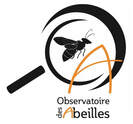Revue d'Hyménoptérologie
Journal of Hymenopterology
ISSN 2727-3806
ARTICLE |
Biologie, observations et collectes de trois espèces sœurs du genre Melitta Kirby, 1802 (Hymenoptera, Melittidae)
|
Simon Dellicour, Denis Michez
|
Citation
Dellicour, S. & D. Michez (2010). Biologie, observations et collectes de trois espèces sœurs du genre Melitta Kirby, 1802 (Hymenoptera, Melittidae). Osmia, 4: 29-34. https://doi.org/10.47446/OSMIA4.7
Published (online) 2010
Indexation • Archivage - Archiving
Résumé
Cet article présente un résumé des données biologiques disponibles sur trois espèces sœurs oligolectiques du genre Melitta (Melittidae), à savoir M. leporina (Panzer 1799), M. nigricans Alfken 1905 et M. tricincta Kirby 1802. Nous présentons également les perspectives d’une analyse comparée en cours visant à étudier l’impact de cet oligolectisme sur la structure génétique de ces espèces.
Mots-clefs
Melitta, spécialisation alimentaire, phylogéographie
Title (translation)
Biology, observation and collection of three sister species of the genus Melitta Kirby, 1802 (Hymenoptera, Melittidae)
Abstract
This article provides a summary of the available biological data on three oligolectic sister species in the bee genus Melitta (Melittidae), namely M. leporina (Panzer 1799), M. nigricans Alfken 1905 and M. tricincta Kirby 1802. We also describe the perspectives of an ongoing comparative analysis evaluating the impact of oligolecty on species genetic structure.
Keywords
Melitta, food specialization, phylogeography
Références - References
Dellicour, S. & D. Michez (2010). Biologie, observations et collectes de trois espèces sœurs du genre Melitta Kirby, 1802 (Hymenoptera, Melittidae). Osmia, 4: 29-34. https://doi.org/10.47446/OSMIA4.7
Published (online) 2010
Indexation • Archivage - Archiving
- DOI: https://doi.org/10.47446/OSMIA4.7
- Zoobank (ICZN): http://zoobank.org/04B8FEE8-8439-40E5-B686-0311A3BF309A
- HAL (CNRS-INRAE): https://hal.archives-ouvertes.fr/hal-03029481
- Zenodo (CERN): https://zenodo.org/record/4394516
Résumé
Cet article présente un résumé des données biologiques disponibles sur trois espèces sœurs oligolectiques du genre Melitta (Melittidae), à savoir M. leporina (Panzer 1799), M. nigricans Alfken 1905 et M. tricincta Kirby 1802. Nous présentons également les perspectives d’une analyse comparée en cours visant à étudier l’impact de cet oligolectisme sur la structure génétique de ces espèces.
Mots-clefs
Melitta, spécialisation alimentaire, phylogéographie
Title (translation)
Biology, observation and collection of three sister species of the genus Melitta Kirby, 1802 (Hymenoptera, Melittidae)
Abstract
This article provides a summary of the available biological data on three oligolectic sister species in the bee genus Melitta (Melittidae), namely M. leporina (Panzer 1799), M. nigricans Alfken 1905 and M. tricincta Kirby 1802. We also describe the perspectives of an ongoing comparative analysis evaluating the impact of oligolecty on species genetic structure.
Keywords
Melitta, food specialization, phylogeography
Références - References
- Banaszak J, 1982. Bees (Hymenoptera, Apoidea) of the Polish coast of baltic sea. Badania Fizjografi czne nad Polska Zachodnia, Seria C, Zoologia 32: 8-38.
- Celary W, 2006. Biology of the Solitary Ground-nesting Bee Melitta leporina (Panzer, 1799) (Hymenoptera: Apoidea: Melittidae). Journal of the Kansas entomological Society 79 (2): 136-145. https://www.jstor.org/stable/25086313
- Edwards RB, 1998. Provisional atlas of the aculeate Hymenoptera of Britain and Ireland, Part II. Biological Records Centre, Huntingdon.
- Iwata K, 1976. Evolution of instinct, Comparative ethology of Hymenoptera. Amerind, New Delhi.
- Michez D & Eardley CD, 2007. Monographic revision of the bee genus Melitta Kirby 1802 (Hymenoptera: Apoidea: Melittidae). Annales de la Société entomologique de France (n. s.) 43, 379-440. https://doi.org/10.1080/00379271.2007.10697535
- Michez D, Patiny S, Rasmont P, Timmermann K, Vereecken NJ, 2008a. Phylogeny and host plant evolution in Melittidae s.l. (Hymenoptera : Apoidea). Apidologie 39: 146-162. https://doi.org/10.1051/apido:2007048
- Michez D, Joris I & Iserbyt S, 2008b. Eco-éthologie des visiteurs de Lythrum salicaria L. (Lythraceae) en Belgique. Belgian Journal of Entomology 10, 37-55. http://zoologie.umons.ac.be/hymenoptera/biblio/01000/34_Michez_Joris_Iserbyt_Lythrum_salicaria.pdf
- Müller A, Krebs A & Amiet F, 1997. Bienen, Mitteleuropäische Gattungen, Lebensweise, Beobachtung. Natur Buch Verlag, Augsburg, 384 p.
- Rasmont P & Mersch P, 1988. Première estimation de la dérive faunique chez les bourdons de la Belgique (Hymenoptera : Apidae). Annales de la Société royale zoologique de Belgique 118: 141-147. https://di.umons.ac.be/details.aspx?pub=0b33c3c8-5e8f-40c0-af4b-26bede21a1d1
- Schmiedeknecht O, 1930. Die Hymenopteren Nord- und Mitteleuropas. Verlag G. Fischer, Jena. https://www.zobodat.at/pdf/MON-E-HYM_0026_0001-1062.pdf
- Tirgari S, 1968. Le choix du site de nidification par Melitta leporina (Panz.), Hym. Melittidae et Melitturga clavicornis (Latr.) Hym. Andrenidae. Annales de l'Abeille 11:79-103. https://doi.org/10.1051/apido:19680201
- Westrich P, 1989. Die Wildbienen Baden-Württembergs. Ulmer Verlag Stuttgart, Band I und II.










